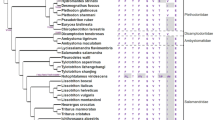Abstract.
Sensitivity to ultraviolet light (UV) is achieved by photoreceptors in the eye that contain a class of visual pigments maximally sensitive to light at wavelengths <400 nm. It is widespread in the animal kingdom where it is used for mate choice, communication and foraging for food. UV sensitivity is not, however, a constant feature of the visual system, and in many vertebrate species, the UV-sensitive (UVS) pigment is replaced by a violet-sensitive (VS) pigment with maximal sensitivity between 410 and 435 nm. The role of protonation of the Schiff base-chromophore linkage and the mechanism for tuning of pigments into the UV is discussed in detail. Amino acid sequence analysis of vertebrate VS/UVS pigments indicates that the ancestral pigment was UVS, with loss of UV sensitivity occurring separately in mammals, amphibia and birds, and subsequently regained by a single amino acid substitution in certain bird species. In contrast, no loss of UV sensitivity has occurred in the UVS pigments of insects.
Similar content being viewed by others
Author information
Authors and Affiliations
Additional information
Received 22 February 2001; received after revision 11 May 2001; accepted 15 May 2001
Rights and permissions
About this article
Cite this article
Hunt, D., Wilkie, S., Bowmaker, J. et al. Vision in the ultraviolet. CMLS, Cell. Mol. Life Sci. 58, 1583–1598 (2001). https://doi.org/10.1007/PL00000798
Issue Date:
DOI: https://doi.org/10.1007/PL00000798




